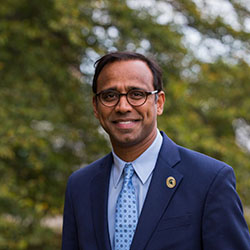In the world of leadership scholarship, “leaders” and “managers” are both necessary, complementary roles. An extremely concise summary of the difference might be: leader = vision, manager = order. It’s a simple enough model, and it has real implications for how people define and perform their duties at work. This is the sort of easily explained, yet nuanced, distinction that fuels much of Dean Prabu David’s recent public-facing blogging and podcasting. It takes seconds to grasp, but the downstream psychological and organizational impacts can be significant.
 This is, in part, because the world of leadership commentary is rife with simplistic, even misleading narratives.
This is, in part, because the world of leadership commentary is rife with simplistic, even misleading narratives.
If you Google “leaders vs. managers,” you’re treated to a bevy of images and checklists contrasting the two titles, and they converge around a single theme: “leaders” are supportive, humble, benevolent, etc., while “managers” are authoritarian and domineering. The two terms are not about function; they’re simply alternate labels for “good” and “bad.” More than one colorful image depicts leaders pulling heavy cargo alongside their teams, while mere managers are themselves the cargo, pointing forward (and likely yelling) while being pulled by struggling subordinates.
The message is clear: “leaders” are good, “managers” are bad, and everyone should aspire to be a leader. It’s the kind of facile organizational thinking that ComArtSci’s Dean David is keen to dispel in the class he teaches for the Strategic Communication Master’s Program. And he has found that many of these practical lessons map well onto bite-sized content for social media.
Dean David is passionate about looking at business in a holistic, human-centered way that retains a healthy dose of pragmatism. He helps his students shatter easy narratives about leadership like the leader/manager distinction one finds through a quick Google search. Crucially, he gives his students — many of them accomplished professionals — the agency and resources to form their own frames within leadership scholarship.
Anyone who has taken Dean David’s class will likely articulate a more nuanced, and appealingly counterintuitive, leadership/management distinction: leaders exist, on some level, to disrupt the status quo of their organization.
A provocative conception, to be sure. But one that’s consistent with leading scholarship from notable industry scholars like Warren Bennis, author of “On Becoming a Leader,” and most anyone writing for the Harvard Business Review. The leader is tasked with strategic vision, innovation, and development; by nature, these processes will result in (hopefully benevolent) destabilization.
In contrast, as the shape of the organization changes shape, it’s the duty of the manager to provide processes to implement leadership’s directives. Perhaps more importantly, it is also the manager’s duty to provide consistency and order across systems and structures.
A nimble, efficient organization requires leaders and managers both.
This, of course, is only one of many manager/leader distinctions. One can find a dozen other explanations of the difference with a little research. But Dean David stresses that the semantics aren’t the core of why such distinctions matter. The leader/manager dichotomy is a useful example of a framing paradigm that, when adopted, can provide professional clarity and purpose to the people with those titles.
As an alumnus, and later a co-facilitator of Dean David’s class, I witnessed seasoned professionals, some with decades of experience, become animated as they experienced small, practical epiphanies about, for instance, supportive vs. directive leadership styles and how they typically map onto employee expertise. I heard highly capable managers say things like, “Now I understand why John is always so aloof!” and “I can’t wait to change the narrative I have with this unit.” And all this from a single set of readings about leadership styles.
Eventually, Dean David realized he was consistently subverting his students’ expectations in the best way possible — many of them admitted to initial skepticism about the abstract, highly psychological course material, only to dub the class their fondest academic experience afterward.
It occurred to Dean David that it didn’t take much actual time or information to give someone a new frame or paradigm about leadership, and he had seen firsthand that the results could make an impact almost immediately.
He began posting articles on LinkedIn, hoping to share some of what has worked in his class with the broader public. The dean has kicked off an early but ambitious series on touring the reader through remarkable leadership content. His reflection on MSU’s strategic plan contains an eloquent summary of how we might envision a land-grant identity for the 21st century. If you know the dean, you won’t be surprised to find his thoughts on MSU goings-on alongside reflection on “flourishing” as a topic that belongs in undergraduate education.
David’s work promotes joy and delight in work and encourages curiosity. While the subject is a departure from his leadership work, that same sensibility shines through every episode of his new podcast, “Life, Meet Tech.” Over nine episodes, David explores the intersection of humanity and technology with a host of futurists and tech experts. Notable is David’s unabashed enthusiasm about emerging technology — a topic that seems to engender far more consternation than excitement in public life. David’s brand of curious, pragmatic optimism is a welcome departure from the gloom that so often surrounds the intersection of life and technology.
For academics and leaders looking to expand their visibility, David’s growing catalog of work for the general public might be a useful object lesson: seek and promote nuance over reductionism; lead with intellectual humility; let the delight of curiosity shine through. And perhaps most importantly: tamp down the inner critic and simply begin.

